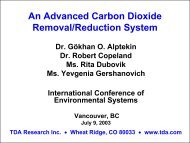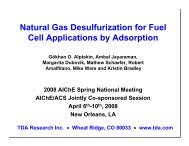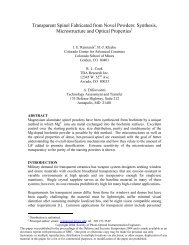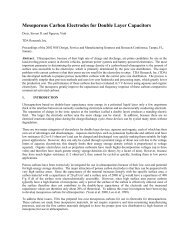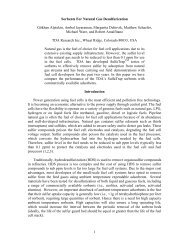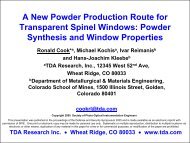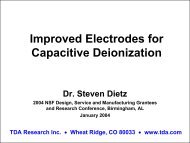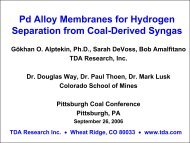Desulfurization of Liquid Fuels by Adsorption for Fuel Cell Applications
Desulfurization of Liquid Fuels by Adsorption for Fuel Cell Applications
Desulfurization of Liquid Fuels by Adsorption for Fuel Cell Applications
Create successful ePaper yourself
Turn your PDF publications into a flip-book with our unique Google optimized e-Paper software.
<strong>Desulfurization</strong> <strong>of</strong> <strong>Liquid</strong> <strong><strong>Fuel</strong>s</strong> <strong>by</strong><strong>Adsorption</strong> <strong>for</strong> <strong>Fuel</strong> <strong>Cell</strong><strong>Applications</strong>Ambal Jayaraman, Gökhan O. Alptekin,Margarita Dubovik, Mathew Schaefer, John Monroeand Lauren Brickner<strong>Fuel</strong> <strong>Cell</strong> Portable Power Systems I2008 AIChE Annual MeetingNovember 16 th -21 st , 2008Philadelphia, PATDA Research Inc. • Wheat Ridge, CO 80033 • www.tda.com
Portable <strong>Fuel</strong> <strong>Cell</strong> <strong>Applications</strong>• Defense <strong>Applications</strong>• Sensor Power (0 - 100 W)• Soldier Power (< 500 W)• APUs (0.5 – 10 kW)• Commercial applications• Recreational vehicles• Emergency power• Automobiles, refrigerated trucks• Currently <strong>for</strong> the < 500 W scale - fuel cells usestored hydrogen, LPG, and methanol/water mix asfuel• Preferred fuel <strong>for</strong>:Defense applications - Jet fuel (JP-8)Commercial applications - Diesel (ULSD)• High energy density• Longer missions/operation hours• No water needed• JP-8 and ULSD contain sulfur and needs to beremoved to produce desulfurized fuel that can beused in the portable PEM/SOFC system to producepower2TDAR e s e a r c h
Military <strong>Fuel</strong> <strong>Cell</strong> APUs• Supplying fuel to the battlefield is one <strong>of</strong>Army’s largest logistic burdens• Delivering JP-8 fuel to Afghanistan cost~$300 per gallon (Mills, 2003)• Even modest gains in fuel efficiency couldsignificantly impact this logistics cost• A fuel cell APU integrated with a BradleyM2A3 Diesel Infantry Fighting Vehiclecould reduce fuel consumption <strong>by</strong> 86% inthe “silent watch” mode• Logistic fuel powered fuel cells can deliverportable power <strong>for</strong> soldiers, squad batterychargers, silent watch “APUs” and powerto ships, UUVs, submersibles, UAVs etc• <strong>Fuel</strong> savings benefit is not the only tacticaladvantage to the military• Near silent operation, reduced heatsignature and reduced space are alsoimportant benefits3TDAR e s e a r c h
Diesel <strong>Fuel</strong> APUs• Commercial long haul truckscould benefit from a fuel cellAPU to increase efficiency andcomply with noise and emissionregulations• The potential fuel savingsprovided <strong>by</strong> improved fuelefficiency could exceed $2billion per year• The power need <strong>for</strong> the truckbasedAPUs are 1-2 kWe• The low sulfur concentration <strong>of</strong>ULSD (< 15 ppmw) makes itpossible to use an expendabledesulfurizer cartridge• The cartridge can beregenerated <strong>of</strong>f-vehicle toreduce complexityAPU Size<strong>Fuel</strong> Flow RateSulfur ContentReplacement Freq.Sorbent SizeSulfur CapacityHeavy Duty TruckDiesel1kWe3.2 mL/min15 ppmw6months1.2 L350 mL/mL4TDAR e s e a r c h
Jet <strong>Fuel</strong> <strong>Desulfurization</strong>5TDAR e s e a r c h
Characteristics <strong>of</strong> JP8 and JP5 <strong><strong>Fuel</strong>s</strong>Hydrocarbon Type JP-8 JP-5Paraffins 71.4 30.8Cycloparaffins 8.0 52.8PAH’s 3.5 No dataOlefins No data 0.5Total paraffins 79.4 83.6Total Aromatics 20.6 15.9• JP-8 and JP-5 are kerosene-likefuels• JP-5 contains more aliphatics toincrease the flash point• Both <strong>of</strong> fuels may contain up to3,000 ppmw sulfur• The sulfur components in the jetand diesel range are referred toas “refractory sulfur”• Benzothiophene• Alkyl-benzothiophene• DibenzothiopheneSulfur compounds in logistic fuelsSource: Song, 20036TDAR e s e a r c h
Sorbent Characteristics• TDA developed SulfaTrap TM -D1 sorbent, a regenerable,physical adsorbent <strong>for</strong> low temperature desulfurization<strong>of</strong> logistics and transportation fuels• Sorbent characteristics:• High sulfur capacity• Regenerability– Small size and reduced replacement frequency• High removal efficiency– Reduce the sulfur concentration <strong>of</strong> the fuel to subppmlevels• Inertness– No undesirable side reactions– No change in fuel properties• Ease <strong>of</strong> handling and disposal– No toxicity, flammability, pyrophorocity7TDAR e s e a r c h
Bench-scale Test SetupSampling valve<strong>Fuel</strong>PumpCeramic heater withReactor-1 insideReactor-2SulfurChemiluminescenceDetector (SCD)<strong>Liquid</strong> sampling8TDAR e s e a r c h
Jet <strong>Fuel</strong> Sulfur Removal Efficiency20000000T=120°C, JP-8 Sulfur Content= ~430 ppmw, LHSV= 1.6 h -1180000001600000014000000Response120000001000000080000006000000400000020000000Desulfurized fuel= 14 mL/gDesulfurized fuel= 9 mL/g0 5 10 15 20TimeSulfur = 430 ppmwSulfur < 1.5 ppmvSulfur < 40 ppbv• SulfaTrap TM -D1 sorbent could reduce the sulfur to sub ppmw levels9TDAR e s e a r c h
Per<strong>for</strong>mance with JP-8 and JP-5total sulfur (ppmw)12001000800600400200JP8JP5T ads= 120 o C, LHSV= 1.6 h -1JP-8 1194 ppmw SJP-51100 ppmw S00 2 4 6 8 10 12mL fuel desulfurized/g <strong>of</strong> sorbent• SulfaTrap TM -D1 achieves higher sulfur capacity <strong>for</strong> JP-5 desulfurization• JP-5 typically has lower aromatic and polyaromatic content than JP-8• JP-8 also has additives <strong>for</strong> static dissipation which contains toluene,naphthalene and nitrogen containing polymers10TDAR e s e a r c h
Effect <strong>of</strong> TemperatureSulfur Concn., ppmwJP-8, 1,450 ppmw sulfur, LHSV= 1.6 h -1140012001000800600400T = 65CT = 90C200T = 120CSulfur Breakthrough capacitiesas a function <strong>of</strong> temperatureAds.Temp.( o C)BreakthroughCapacity(mg S/g)SaturationCapacity(mg S/g)65 2.2 2.890 2.8 4.2120 3.0 4.100 1 2 3 4 5 6<strong>Fuel</strong> Desulfurized, mL/g• Sulfur capacity slightly increases with temperature• At higher temperatures the sorbent’s interactions with unsaturatedhydrocarbons are significantly weaker than those with sulfur• Higher operating temperature is desirable to reduce the ∆T neededsorbent regeneration11TDAR e s e a r c h
Options <strong>for</strong> Regeneration Gas201816Regens in 2%H 2 /HeCycle # 1 = 7.0 mL/gCycle # 2 = 3.6 mL/gCycle # 3 = 1.6 mL/gCycle #4-14 = 0.3-0.5 mL/gTDA SulfaTrap (1/16" pellets)Optimization <strong>of</strong> Regen Gas @ 400-450 o CCycling Data - JP-5 with 500 ppmw SSulfur concn. (ppmw S)141210864Regenerations inH2%H 2 Regens2 /HeCycle # 4-14Cycle# 4-14Air RegenerationsCycle# 27-67Regenerations in airCycle # 27-52Air RegenerationsRegenerationsfollowed <strong>by</strong>inH 2air Reduction& 2%H 2 /HeCycle# # 15- 15-26200 0.5 1 1.5 2 2.5 3mL <strong>Fuel</strong> Desulfurized/g <strong>of</strong> Sorbent• SulfaTrap TM -D1 sorbent can be regenerated <strong>by</strong> using hot air,reducing gas or an inert gas12TDAR e s e a r c h
Multiple Cycles with Air RegenerationSulfur concn. (ppmw S)252015105TDA SulfaTrap TM -D1 (1/16" pellets)Cycling Data with air regeneration @ 400 o CCycle #1 - Cycle #90#17#18#3#2#15#90#51#58#1900 0.5 1 1.5 2mL <strong>Fuel</strong> Desulfurized/g <strong>of</strong> Sorbent• SulfaTrap TM -D1 sorbent maintained its capacity <strong>for</strong> over 100 cycles13TDAR e s e a r c h
TDA’s Jet <strong>Fuel</strong> Desulfurizer21”26”26”• A stand alone prototype desulfurizer was built to remove sulfurcompounds directly from liquid fuels (e.g., JP-8, JP-5, diesel fuel)• The unit is sized to 3 kWe and treats up to 10 mL/min fuel with up to3,000 ppmv sulfur)14TDAR e s e a r c h
Manifolds and ConnectionsAir OutIn-line Electric GasHeater<strong>Fuel</strong> OutAir InThermocouple wellsValve &ActuatorMicro-switchindicatorReactor<strong>Fuel</strong> In15TDAR e s e a r c h
Sorbent ReactorsRegenerationAir OutletRegenerationAir Inlet<strong>Fuel</strong> Outlet3”φ 3”ØThermocouple14”SupportScreensSorbentSorbentFill PortThermocouple<strong>Fuel</strong> Inlet16TDAR e s e a r c h
Cycle SequenceCycle Time (Hours)BED 1012 3 4 5 6 7 8BED 2BED 3BED 4ADSORPTION (120 MIN)DRAIN (15 MIN)HEATING (70 MIN)REGENERATION (210 MIN)COOLING (30 MIN)Full-cycle time = 8 hrsFILL (35 MIN)• Four beds undergo six steps to achieve continuous desulfurization• 1) <strong>Adsorption</strong>, 2) Drain, 3) Heating, 4) Regeneration, 5) Cooling, 6) Fill• One bed always remains on-line, while other beds regenerate or undergoheating/cooling and fill/drain transitions171TDAR e s e a r c h
High Temperature <strong>Fuel</strong> <strong>Desulfurization</strong>• SulfaTrap TM -D1 sorbent works muchmore effectively at 200 o C and 75 psig• In order to maintain fuel in the liquidstate, the fuel is pressurized to 75 psig at200 o C during adsorptiontotal sulfur (ppmw)500400300200100TDA- SulfaTrap TM - D1JP-8 ~ 430 ppmw S200 o C & 75 psig200C, 75 psig120C, ambientTotal Sulfur Conc, ppmw350300250200150100500#5#6Cycle #1Cycle #2Cycle #3Cycle #4Cycle #5Cycle #6TDA SulfaTrap TM -D1JP8 ~ 430 ppmw S0 5 10 15 20 25mL <strong>Fuel</strong> Desulfurized/ g sorbent#100 4 8 12 16 20 24mL fuel desulfurized/g <strong>of</strong> sorbent• Higher adsorptiontemperature and reducedT swing betweenadsorption andregeneration also has afavorable impact onsystem18TDAR e s e a r c h
Next Generation Desulfurizer Design• The next generationdesulfurizer (3 kWe) isdesigned to fit into20”x12”x 16.5”• By eliminating redundantpieces and using custombuiltcomponents• Increased energy densityis expected <strong>for</strong> largersystems since the size <strong>of</strong>the auxiliary equipment(valves etc.) will notproportionally increasewith system size19TDAR e s e a r c h
Diesel <strong>Fuel</strong> <strong>Desulfurization</strong>20TDAR e s e a r c h
<strong>Desulfurization</strong> <strong>of</strong> Diesel <strong>Fuel</strong>T ads= 120 o C LHSV = 1.6 h -1 MoSulfur Concn. inCollected <strong>Fuel</strong> (ppmw)108642Proprietary CarbonSelexsorbTDA-SulfaTrap-D1ULSD <strong>Desulfurization</strong> @ 120 o C4,6-dimethyldibenzothiopheneS00 20 40 60 80 100 120<strong>Fuel</strong> Desulfurized mL/g• SulfaTrap TM -D1 can desulfurize 100 mL <strong>of</strong> ULSD per g sorbent with 90+%removal efficiency reducing the sulfur content to less than 1 ppmw21TDAR e s e a r c h
Diesel <strong>Fuel</strong> – Removal Efficiency4,6-dimethyldibenzothiopheneT=120°C, Sulfur Content= ~10.5ppmw, LHSV= 1.6 h -1SMoSulfur < 0.4 ppmvDesulfurized fuel= 20 mL/g• SulfaTrap TM -D1 sorbent could effectively desulfurize the ultra low diesel fuel<strong>for</strong> fuel cell applications• Recent <strong>for</strong>mulations could desulfurize up to ~650 mL <strong>of</strong> fuel per g sorbent22TDAR e s e a r c h
Extended Testing1412ULSD - 14.1 ppmw S (inlet) onSulfaTrap TM -D1(P = 125 psig)350300ppmw sulfur10864cumulative average sulfur in effluent<strong>Fuel</strong> <strong>Adsorption</strong> Temp.250200150100Temperature, o C25000 100 200 300 4000mL <strong>Fuel</strong> Desulfurized/mL <strong>of</strong> Sorbent• The extended testing <strong>of</strong> SulfaTrap TM -D1 provided ~ 400 mL <strong>of</strong> desulfurizedfuel per mL <strong>of</strong> Sorbent with < 3 ppmw S cumulative average sulfur leakage• SulfaTrap TM -D1 had increased capacity and removal efficiency at highertemperature and lower space velocityTDAR e s e a r c h
Straight-cut Diesel <strong>Desulfurization</strong>total sulfur (ppmw)T=120°C, Sulfur Content = 120 ppmw, LHSV= 0.8 h -15040302010Cycle #1Cycle #2Cycle #3Cycle #4Cycle #6Cycle #7#6#1#7#3#4#20TDA- SulfaTrap TM - D10 1 2 3 4 5mL fuel desulfurized/g <strong>of</strong> sorbent• TDA SulfaTrap TM -D1 provided good per<strong>for</strong>mance <strong>for</strong> desulfurization <strong>of</strong>straight-cut dieselTDAR e s e a r c h
Conclusions• SulfaTrap TM -D1 sorbent is highly effective <strong>for</strong> deepdesulfurization <strong>of</strong> jet fuel• The sorbent is regenerable in air and/or reducing gasat 400 o C and maintains its per<strong>for</strong>mance over manycycles• TDA is demonstrating the concept in a practicalbreadboard prototype desulfurizer• The sorbent is successful <strong>for</strong> desulfurization <strong>of</strong> bothULSD and straight-cut diesel• TDA has successfully demonstrated SulfaTrap TM -Psorbent <strong>for</strong> desulfurization <strong>of</strong> LPG in-line with portablefuel cells25TDAR e s e a r c h



